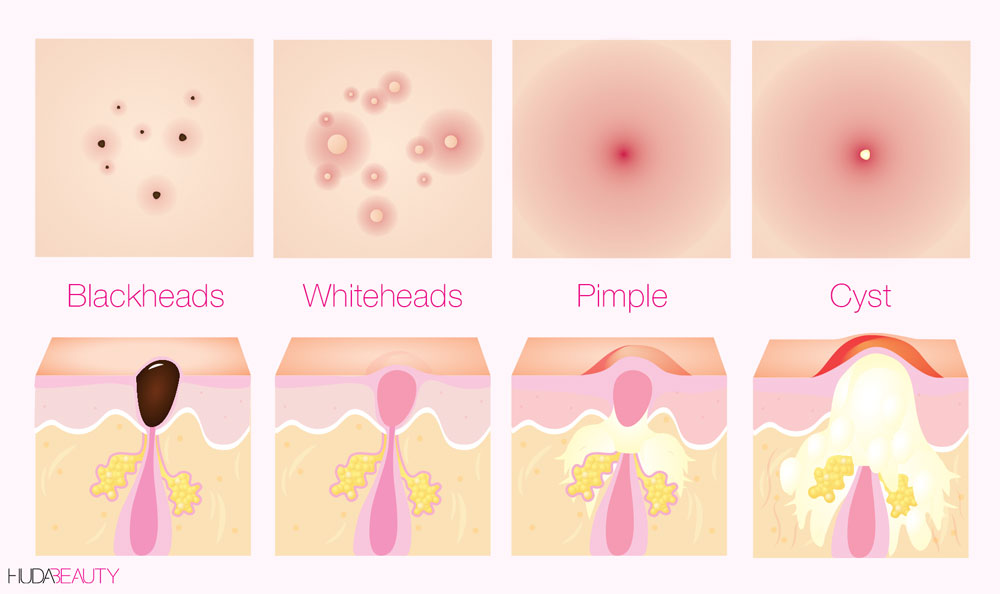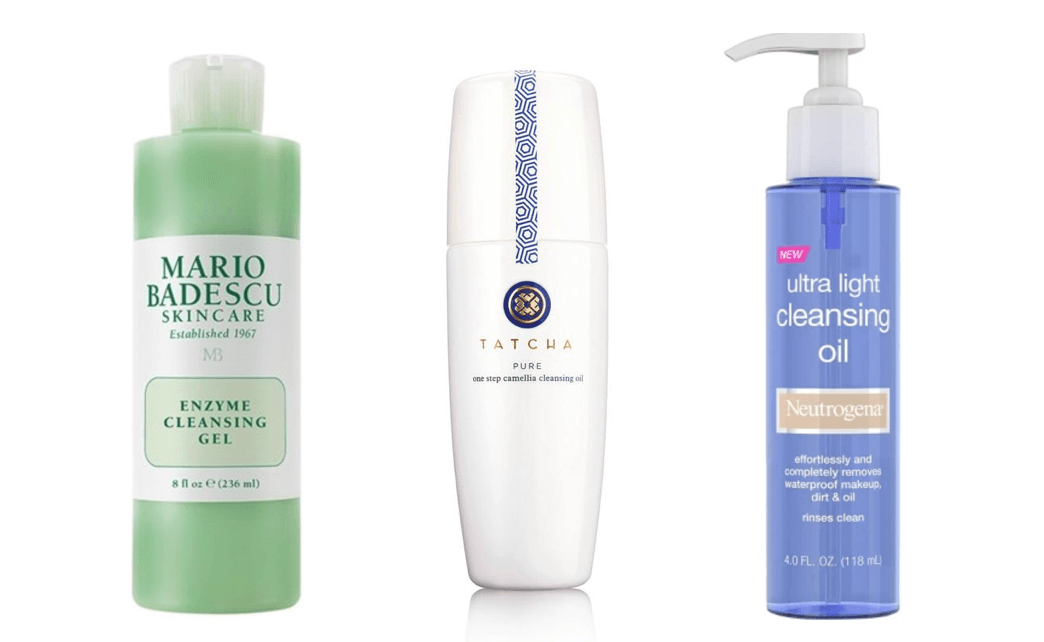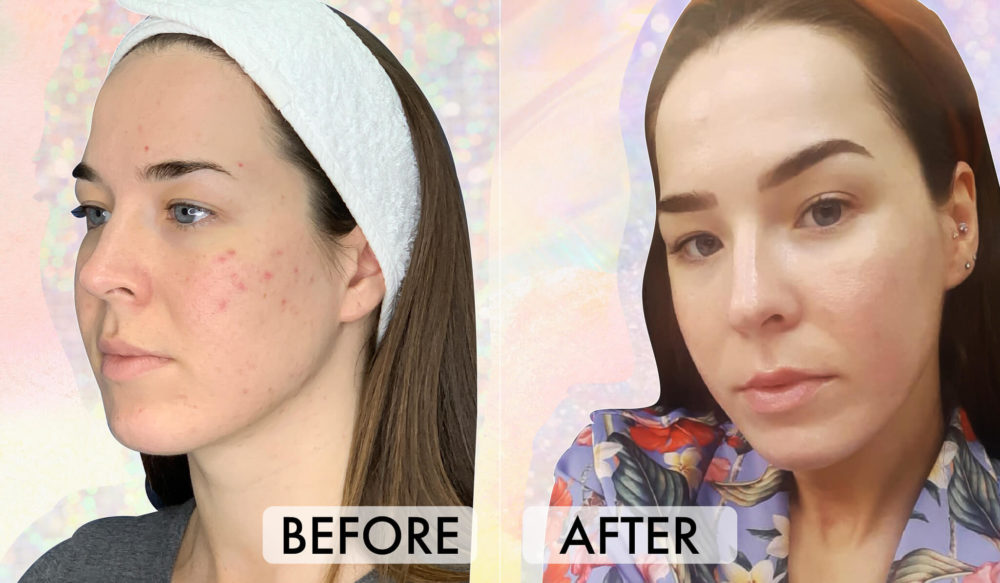The Ultimate Skin Routine To Treat And Calm Acne
 Source: ViChizh/Shutterstock
Source: ViChizh/Shutterstock
One of the most common skincare issues that we’re constantly asked about is acne. Sometimes it can seem like a struggle to find the right products and ingredients to soothe acne-prone skin, but we promise, with the right information and guidance, you can learn to calm your breakouts. Just remember, knowledge is power when it comes to acne, so understanding what causes skincare and what aggravates acne is essential. So, we’ve created a guide containing the most useful information, acne treatments, and acne skincare tips that we’ve learned over the years
Here’s everything you need to know:
What Causes Acne:
Acne occurs when your hair follicles (pores) become blocked with a combination of dead skin cells and sebum (the natural oil your skin produces). This then causes whiteheads, blackheads, and pimples to form. If your acne is severe, you could also have cystic acne, which means the infection has gone deeper into your skin and the pore has become inflamed causing a bump of pus to form. It’s really important to be able to identify the type of pimple you’re experiencing because different treatment is necessary for each.
Types of Pimples:

Whitehead: This is a hair follicle that’s blocked by dead skin cells piling up once the follicle opening is blocked. This is smaller and less inflamed than a cyst. You should never pop a white head but instead, apply a topical spot cream. You can also use a retinoid cream as a way of preventing more whiteheads, as they stop dead skin cells from clogging pores and allow the skin to absorb treatments better.
Blackhead: This is essentially a whitehead that becomes exposed to oxygen, which oxidizes the contents making it turn black. Salicylic acid is great for both preventing and treating blackheads, as its oil-soluble and its small molecular structure means it can penetrate deep into the pore, where the acid then breaks down the ‘glue’ that binds the blockage. You can also use nose strips; we’re obsessed with the Biore Deep Cleansing Pore Strips, $10 (which you can bi-weekly), or a blackhead extractor to remove blackheads, but the latter needs to be done very carefully (find out how here).
Pimple: This is an overgrowth of bacteria called p.acnes, which stimulate an immune response that creates redness, swelling, pain and sometimes pus. For a quick and easy DIY, lightly press a hot (not too hot) flannel onto your skin to open your pores, then dab tea tree oil or a piece of fresh ginger onto the blemish, which both have antibacterial and anti-inflammatory properties.
Cyst: Cysts tend to be more painful, larger, redder and more raised than a whitehead. You should never try to pop a cyst, as these can lead to a spread of bacteria and more inflammation, which only means it will take longer to go away. For our full dermatologist’s guide to treating cystic acne, check out our guide here.
Nodule: This is another severe type of acne, similar to a cyst. A nodule, like a cyst, is a solid, large and painful lump below the surface of the skin. Unlike a cyst, it doesn’t have a head and the lump of dead skin and sebum will remain intact and could be there for weeks or even months. Retinoids and salicylic acid can be used to help unclog the trapped debris, but it’s best to have this treated with prescription ointments or antibiotics from your doctor.
Daily Skincare Regime for Acne-Prone Skin
 Via Giphy
Via Giphy
If you have acne-prone skin, a consistent regime with products specifically made to soothe and regulate oil production can help rebalance the skin, reduce flare-ups, and boost skin regeneration. Alternatively, using the wrong formulas and ingredients can wreak havoc, which is why it’s super important to tailor your regime with care. To help, we consulted the experts for their advice on how to treat acne-prone skin like a pro. Here’s our derm-approved guide, including all of our fave products – obvs!
Step 1: Cleanse
Dr.Friedmann a leading dermatologist at The Harley Street Dermatology Clinic insists that the first step to a good regime is “gentle cleansing, both in the morning and evening, as it’ll relieve oiliness.” This will also help decongest your pores and lower the chances of breakouts. Using the right cleanser is extra important; a gel or foam cleanser is ideal for oily and acne-prone skin as it’ll clean deep into pores without leaving any residue.
Morning: Use a foam or gel cleanser and look for products with antibacterial ingredients like tea tree or honey as they help reduce acne bacteria in the skin. We’re currently obsessed with the Mario Badescu Enzyme Cleansing Gel, $14, which contains natural exfoliants like papaya and grapefruit, which will prevent dead skin build-up that can cause blackheads and pimples.
Evening: Always double cleanse to ensure you’ve removed all traces of makeup and any dirt, bacteria or pollution from your skin. As a first step, cleansing oils are a good option, as the oil will mix with any excess sebum sitting on the surface of your skin and will be washed away with the cleanser. Plus, as they’re typically antibacterial and anti-inflammatory, they can help soothe your skin. We like the Tatcha Pure One Step Camellia Oil Cleanser, $50, which is infused with antioxidant-rich vitamins A, B, D, and E, that’ll replenish the skin and minimize the appearance of scars.
 Source: Mario Badescu, Tatcha, Neutrogena
Source: Mario Badescu, Tatcha, Neutrogena
Neutrogena’s Ultra-Light Face Cleansing Oil & Makeup Remover, $9, is another great drugstore alternative. This should then be followed with a water-based, foam or gel cleanser. Read our guide on double cleansing for more deets on this amazing K-beauty ritual.
Step 2: Tone
A good toner is essential for acne-prone skin as it’ll help minimize the appearance of pores, balance oil production and brighten and even out skin tone. Look for a toner that contains chemical exfoliants to help shed any dead skin and decongest your pores, lessening the chance of breakouts. Ingredients like salicylic acid and glycolic acid are your skincare holy grail, so keep an eye out for these. Natural ingredients like ginseng, chamomile, and rose are also amazing as they’re packed with antioxidants that’ll reduce inflammation and soothe skin.
Morning: Start your day with a soothing toner, that contains hydrating ingredients like hyaluronic acid, aloe vera or ginseng. We love the Khiel’s Cucumber Herbal Alcohol-Free Toner, $32, as it’s really gentle on the skin and doesn’t leave it feeling tight, and the super soothing Mario Badescu Witch Hazel & Lavender Toner, $14.
Evening: At night, it’s time to amp up your formula; look for potent ingredients that will wipe away any last traces of makeup and tighten your pores. Use a toner that contains AHA’s, like the Pixi Glow Tonic, $15, which is infused with glycolic acid or COSRX’s One Step Original Clear Pad (70pcs), $22, which contain willow bark extract and tea tree leaf oil to fight acne bacteria and reduce inflammation and swelling. Another toner we love for acne-prone skin is the Caudalie Vinopure Natural Salicylic Acid Pore Minimizing Toner, $30, for evening.
Posts You'll Love:
Step 3: Serum
Morning: Opt for a hydrating serum or a vitamin C formula to protect your skin, like the Glow Recipe Pineapple-C Brightening Serum, $39, which contains Vitamin C, AHAs, smoothing pineapple juice and hydrating hyaluronic acid to brighten and even tone.
 Source: Sephora
Source: Sephora
Evening: Choose a more intense serum to clean deep into pores, like The Inkey List’s Beta Hydroxy Acid (BHA) Blemish + Blackhead Serum, $12, which contains 2% salicylic acid, 1% zinc salt compound to reduce excess sebum, and hyaluronic acid to hydrate the skin. We also love the Caudalie Vinopure Natural Salicylic Acid Pore Minimizing Serum, $52, that’s packed with salicylic acid, purifying rose water, and antioxidant-rich grape seed extract, plus non-comedogenic essential oils with antiseptic properties.
Step 4: Moisturize
One of the most common skincare myths is that if you have oily or acne-prone skin, you don’t need to moisturize, but this is SO not true! It’s possible to have dehydrated yet oily skin. In fact, the more dehydrated your skin is, the more oil it’ll produce to lubricate your skin cells. So, make sure you’re moisturizing morning and night with a lightweight formula that’s ‘non-comedogenic,’ it won’t block pores, and ‘non-acnegenic,’ which means it has been specifically tested for acne-prone skin and doesn’t contain any aggravating ingredients. Other amazing ingredients to look out for include hydrating hyaluronic acid, and salicylic acid, which will help nix your pores and balance breakouts.
Morning: One of our all-time fave moisturizers is the Tatcha The Water Cream Oil-Free Pore Minimizing Moisturizer, $69, and it’s suitable for all skin types. It literally melts into the skin and is infused with Japanese wild rose and lily, which helps purify the skin, tighten pores, and smooth texture. You can also try Neutrogena’s non-comedogenic Rapid Clear Acne Defense Oil-Free Face Lotion & Moisturizer, $10.
Evening: At night, you can afford to use a heavier formula as this is when your skin loses the most moisture. Mizon’s All-In-One Snail Repair Cream, $24, is formulated with a 92% snail extract, which helps soften acne marks and hydrate the skin without being too heavy – it sounds gross but it’s amazing.
Posts You'll Love:
Tip: Skip the face oil! If there’s one skincare step you should skip, according to Dr.Timm Goueleke, creator of the skincare brand Royal Fern and Founder of the Dr. Golüke Clinic, it’s a face oil. Dr.Goueleke warns against them stating “rich face oils and essential oils will plug your pores,” ultimately leading to breakouts. Dr. Dennis Gross, Founder of the Dr. Dennis Gross skincare line, agrees stating that, “You should look for oil-free products and stay clear of products with natural oils – adding these to an already oily skin type can result in clogged pores and breakouts.”
However, there are some oils specifically targeted for acne-prone skin, like Sunday Riley U.F.O. Salicylic Acid BHA Acne Treatment Face Oil, $80, which contains 1.5 percent salicylic acid, and tea tree oil and black cumin seed oil to support clear skin.
Step 5: SPF
Another widely believed skincare myth is that sun exposure helps combat breakouts, but this is NOT true! While it can feel like the sun dries out pimples, it’s actually seriously damaging for your skin. Especially for acne-prone skin, if you’re using products containing AHAs, which make your skin more sensitive to UV rays. The sun can also make scars appear darker, so if you have acne-scarring, by wearing an SPF it’ll help your scars heal and soften more quickly than if they were exposed to the sun.
As per usual, look for a lightweight cream that’s SPF 30 with a 5-star UVA rating during the summer months and a formula containing SPF in the winter. We’re currently using Supergoop’s Unseen Sunscreen SPF 40 PA+++, $20, as the oil-free formula helps minimize shine while protecting your skin against UVA and UVB rays.
Weekly Skincare Steps:
 Via Giphy
Via Giphy
Exfoliate
Exfoliation is also another crucial skincare step for acne-prone skin. Although Dr. Dennis Gross insists that you should “avoid harsh scrubs and over-drying skin as this will result in your skin increasing its own natural production of oil to compensate for the dryness caused by products, further exasperating the problem.”
Instead, opt for a chemical exfoliator, which is an enzyme or acid-based formula. Chemical exfoliants have a smaller molecular structure, which means they can penetrate deeper into the skin to dissolve and dislodge the glue that binds dirt in your pores and causes dead skin cell build-up. Look for AHAs like glycolic and lactic acid, as well as BHAs like salicylic acid. Dr. Dennis Gross highly recommends salicylic acid as “it’s oil soluble so it’s able to deeply penetrate and unclog oil-ridden pores.” It’s also anti-inflammatory and antibacterial so it’ll help stamp out any acne bacteria in the skin.
Evening: We prefer to exfoliate at night, as it gives your skin time to heal and replenish before being exposed to the sun. Especially, if you’re using an ingredient as potent as The Ordinary’s AHA 30% + BHA 2% Peeling Solution, $10. It’s one of our faves as it packs a serious punch featuring four types of AHA’s, as well as salicylic acid and hyaluronic acid to hydrate (although you should only need to use it every other week). We also like the Go-To Exfoliating Swipeys, $46, as they’re infused with lactic acid to remove any dead skin, as well as aloe Vera to soothe any existing pimples.
Avoid exfoliating more often than three times a week, and on the days that you do exfoliate, avoid using your products that contain AHAs and BHAs.
Posts You'll Love:
Mask
A detoxifying face mask is another great weekly addition for acne-prone skin. Within 15 minutes, you can help reduce oiliness, decongest your pores, and soothe inflammation. You just need to find masks with mattifying and cleansing ingredients like salicylic acid or purifying clay. We like the Be Barefaced Dead Sea Mud Mask, $23 – it’s infused with dead sea minerals, and kaolin clay to remove dirt and grime while also absorbing excess sebum leaving your skin feeling fresh and clean. We also love the L’Oréal Pure Clay Mask, $18, it’ll help rid your skin of any excess oil, while the eucalyptus, which has natural astringent properties, will regulate sebum as well as tighten, tone, and brighten your skin.
Retinol
While the idea of using a retinol may be scary, it can actually be beneficial for acne-prone skin. If used regularly, it can help decongest your pores, making them appear smaller and balance breakouts, and as it boosts skin cell turnover, it’ll soften the appearance of acne scars. Plus, it’s also an anti-inflammatory so it’ll soothe swelling and redness.
With that said, you need to introduce retinol into your regime gradually. Start by using it twice a week for the first month and then increase usage slowly. We’re currently using the Philosophy Help Me Retinol Night Treatment, $50; it’s water-based, so it won’t clog your pores. Use it at night, under your moisturizer for the best results. The Inkey List’s Retinol Anti-Aging Serum, $11, is another great retinol and it’s a lot more budget-friendly. The formula contains 1% retinol, and 0.5% granactive retinoid (retinol’s slightly stronger sibling), as well as squalane for soothing, which is super potent considering the price tag!
Daily Habits that Can Make a Difference:
 Via Giphy
Via Giphy
Your skincare regime may be BOMB, but if you’re guilty of any of the following habits, these could be contributing to your breakouts.
Stressing out: Stress releases the stress hormone cortisol, which causes your oil glands to produce more sebum (oil), which can then clog your pores and lead to breakouts. Check out our post for stress-busting tips here.
Not being a clean freak: By not cleaning the beauty tools or devices that you use on your face regularly, you risk transferring bacteria to your face and clogging your pores, which can trigger breakouts. So, start getting OCD about cleaning your phone, makeup brushes, and changing your pillowcases on a weekly basis.
Touching your face: On average, we touch our faces more than three times an hour, and by doing so we’re relocating bacteria and dirt to our face. As tempting as it is, never pick your pimples; this will just aggravate them further, making them more inflamed and more likely to scar.
Your diet: The correlation between your diet and skin is closely connected. Dairy products, in particular, have been shown to trigger breakouts due to the hormones in milk, so where possible try to avoid cheese and cow’s milk and instead try almond or coconut milk, and vegan cheese or yogurt. Other foods you should steer clear of include dried fruit, fizzy drinks, and milk chocolate – these foods contain a high amount of sugar, which cause inflammation and can dehydrate and irritate your skin. Check out this ahhhmazing healthy chocolate alternative here.
Acne Home Remedies & Acne Products

Source: Mario Badescu, Boots, The Ordinary
Mario Badescu Drying Lotion, $17: This drying solution is amazing at taking down pimples overnight as it helps to dry out blemishes and reduce redness and inflammation. Check out why we love it so much here.
Banana peels: Use the peel of a ripe banana and rub it directly onto a pimple – leave it on for 30 minutes and then wash your face, and repeat twice, daily. Banana peels are packed with anti-inflammatory ingredients as well as enzymes that help soften scars. If you don’t believe us, take a quick read of these reviews on acne.org here.
Witch Hazel: Witch hazel is ideal for treating acne as it’s a natural astringent, so it will help draw out bacteria, dirt, and oil in your skin. We love applying the Boots Tea Tree & Witch Hazel Spot Wand, $7, as it has a day and a night formula for 24-hour control.
The Ordinary AHA 30% + BHA 2% Peeling Solution, $8: This chemical exfoliator uses glycolic, lactic, tartaric, and citric AHAs, and Salicylic acid to exfoliate dead skin for a super deep pore cleanse that helps to fade blemishes and scarring.
As with all skincare issues, if you feel like your skin isn’t right or it’s not under control, it’s always best to consult your dermatologist.
























Leave a comment